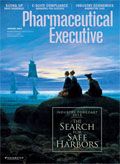Country Report: Singapore
Most executives across the pharmaceutical industry agree-Singapore does not represent any question marks in the future. Furthermore, Singapore's location is ideal for reaching markets east, west, north and south, which form the powerhouse that is Asia-Pacific.
This sponsored supplement was produced by Focus Reports.
Project Director: Mary Carmen Luna
Project and Editorial Coordinator: Aleksandra Klassen
Project Publisher: Ines Nandin
Editor: Fred Gebhart
For exclusive interviews and more info, please log onto Pharma.FocusReports.net or write to contact@focusreports.net
Thousands have followed Tom Waits' "we sail tonight for Singapore" beckoning call.

"Status" by Jane Lee
Today, Singapore is the second most densely populated country on the planet (after only Monaco,) with a population of over five million in 435 square miles.
Ranging from the quaint—Prime Minister Lee Hsien Loong urging Singaporeans to procreate—to the ascetic—a hard-line legal system where capital punishment is allowed—the government blankets the city-state. Occasionally, it is difficult to decipher whether its denizens are living in a contemporary "1984," which has managed to convince the rest of the world of its superiority, or whether an administration can really be so cohesive and so responsive that the public's universal woes are eradicated.
So call it an Orwellian-esque tale, "Asia-light", as it is called by excited greenhorns and haughty expats alike, or the Silicon Valley of the East. In under 50 years, Singapore has managed to develop a knowledge-based economy. For the seventh consecutive year it has been awarded the best business environment by the World Bank and currently ranks as the 4th highest GDP per capita.
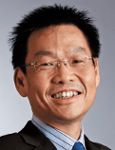
Keat Chuan Yeo, Executive Director Singapore Economic Development Board
Most executives across the pharmaceutical industry agree—Singapore does not represent any question marks in the future. Furthermore, Singapore's location is ideal for reaching markets east, west, north and south, which form the powerhouse that is Asia Pacific.
BUILDING THE BUTTRESSING BLOCKS
It is precisely Singapore's ability to fill in the blanks of global demand that enables it to consistently evolve and convert conventional disadvantages—size to agility, inexperience to enterprise—in order to designate itself as a hub for you-name-it.
In order to make biomedical sciences the fourth pillar of the economy (after electronics, engineering and chemicals), Singapore needed to solve two problems: Make the island a prime location for manufacturing in order to lure more multinationals (MNCs) and build infrastructure to enhance R&D capabilities. That meant increasing hospitals' and universities' capabilities to conduct translational clinical research as well as acquiring both homegrown and recruited talent. The solution—the Biomedical Science Initiative (BMS Initiative)—developed in 2000 with the goal of creating a sustainable biomedical sciences industry.

Swee Yeok Chu, President & CEO EDBI - Economic Development Board Investments
The trilogy of the government organizations responsible for creating the BMS– The Singapore Economic Development Board (EDB), which attracts investment into Singapore; EDB Investments (EDBI), the strategic corporate investment arm, and Agency for Science, Technology and Research, A*STAR, which promotes local research and talent– all insist that their commitment is unyielding and that the initiative is on track.
From 2011 to 2015, the government has committed SGD 16.1 billion (USD 13.2 billion) to R&D, of which about 40 percent has been allocated to biomedical sciences—a 12 percent increase from the previous budget allocation, explains Benjamin Seet, executive director of the Biomedical Research Council of A*STAR.
This four-year span is considered the third phase of the initiative, which consists of working with the industry to generate improved economic outcomes.

Benjamin Seet, Executive Director, Biomedical Research Council (A*Star)
The biomedical sciences manufacturing output has already increased four-fold from SGD 6 billion per year (USD 5 billion) in 2000 to SGD 27 billion (USD 22 billion) in 2011. Furthermore, 22 percent of the total manufacturing value-added is derived from biomedical sciences.
In order to keep the momentum, the EDB is continuing to pursue their "Host to Home" strategy, which aims for Singapore to become companies' home in Asia, rather than just being a host. After laying the groundwork for many "firsts", Bio*One, (the government's biomedical sciences investment division), is harnessing recent success in the medical technologies industry. Its past achievements include establishing S*BIO, Singapore's first private R&D company, and Maccine, the first preclinical company in Singapore.
Completing the trilogy is A*STAR. In addition to developing indigenous talent with a full "pipeline that extends as far into the future as 2022," A*STAR has enacted a Master Research Collaboration Agreement (MCRA) that has been signed by companies like Roche and GE Healthcare.

James Kaw, Director Singapore Innovation Center (P&G)
The dynamic of what Seet describes as MNCs moving "towards open innovation and leveraging on public sector research rather than developing everything in-house," will provide opportunities for collaboration. The MCRA will enable MNCs to work with different public institutions, including A*STAR institutes, universities, and hospitals, from one single entry point.
In addition, the Health Sciences Authority (HSA), Singapore's regulatory authority; the National University of Singapore (NUS), and the Nanyang Technological University (NTU), have played integral roles in fostering interconnectivity to further advance the BMS.
Although there have been setbacks in consolidating the Biopolis of Asia, like the 2010 closing of the Lilly Singapore Centre for Drug Discovery, Singapore is still attracting investments from big names. Novartis has committed USD 500 million to construct a biotech manufacturing facility. Proctor & Gamble's (P&G) 105,000 square foot, USD 192 million Innovation Center in the Biopolis is scheduled to be fully operational by mid-2013.
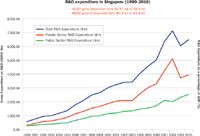
R&D expenditure in Singapore (1990-2010)
James Kaw, the director of the Singapore Innovation Center, cites the country's strength in the biomedical field as one of the principal reasons P&G decided on this location. The center, P&G's first in 20 years, will focus on beauty products, hair care, skin care, air care and personal health.
"What is important is that the industry continues to grow and the capabilities we have built are anchored in Singapore and can be redeployed," says Keat Chuan Yeoh, managing director of the EDB.
Public-private partnerships (PPP) are part and parcel of the anchoring plan. GlaxoSmithKline (GSK), for example, has a SGD 2 million (USD 1.6 million) PPP between GSK Vaccines and A*STAR's Bioprocessing Technology Institute to collaborate on vaccine and adjuvant system-related research projects. In 2010, GSK launched the GSK-Singapore 10 Year Strategic Roadmap in partnership with the EDB. A joint fund of SGD 50 million (USD 41 million) is dedicated to building capabilities in the areas of green manufacturing and healthcare policy in Asia.
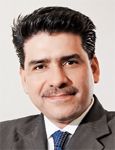
Augusto Muench, Regional Director South East Asia & MD Singapore Boehringer Ingelheim
THE BIG GUNS: BRANDISHING OR RE-POLISHING?
While the global pharmaceutical market has been trundling along with around a 2 to 4 percent annual growth, China and Indonesia are leading Asian growth with approximately 15 percent annual growth, explains Rhenu Bhuller Frost & Sullivan's Vice President of Healthcare for Asia Pacific. As the pharma world continues to crane its neck towards the east, Asia is seen as a cornerstone for boosting sales. According to the Economist Intelligence Unit, regional pharma sales have more than doubled from USD 97 billion in 2001 to over 214 billion in 2010 and are expected to reach 386 billion by the year 2016.
"Southeast Asia is one of the fastest growing regions in the world for us and our expectation is that it will continue growing in the coming years," says Augusto Muench, regional director, South East Asia and managing director of Singapore for Boehringer Ingelheim (BI). Last year, 16 percent of the company's total growth was attributed to the Association of Southeast Asian Nations (ASEAN).
Although Patrick Bergstedt, president of MSD, Asia Pacific believes that "the growth of the emerging markets has to counterbalance the pressure in the US and in Europe," Asia is no longer the low-hanging fruit. Opportunities are riddled with challenges.

Fabio Landazabal, Senior VP & Area Director, Asia Pacific GSK
Besides a tougher healthcare environment that makes it costly to develop original compounds, Bergstedt says that Asia's cost of entry is much higher due to generic competition. "Also problematic are the hurdles for doing clinical studies, getting drugs approved, and dramatically escalating reimbursements pressures."
The situation is complicated and growth is stifled by the conundrum of funding.
"Governments want to properly expand healthcare access worldwide, therefore require proper funding for it. On the other hand, research based pharmaceutical companies, such as ours, with innovative molecules want to continue their research, which also requires funding." In the middle of both, explains Muench, "there are physicians that need to be able to provide those innovative products to patients that are in need."
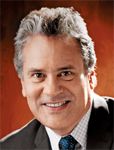
Patrick Bergstedt, President Asia Pacific MSD
And if growth is ultimately guaranteed, sustainability is not.
"I doubt that the current business model we operate in could withstand and be sustainable given these challenges," concludes Muench.
Fabio Landazabal, senior vice president and area director, Asia Pacific for GSK agrees: "The pharmaceutical model is at a stage where it might benefit from strategic collaborations with diverse industries such as IT and banking."
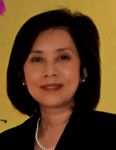
Christina Teo, Country Manager, Pfizer Singapore
The industry is shifting towards the two-brains-are-better-than-one route. Collaborations and partnerships are seen, if not as a cure-all, then undoubtedly as mandatory to cope with the complexities.
"In this perspective, we have to forge partnerships to see how we can help play a role. The price of medicine is just one component; we have to look at the cost of healthcare, which includes the price of medicines, infrastructure, supply logistics, training of healthcare personnel, etc.," says Bergstedt, who is hoping to bring MSD up to third place in Asia Pacific, from its current rank of fifth.
AMIDST THE FLUX, SINGAPORE IS A BEACON
Big pharma has settled into Singapore quite comfortably. Companies ubiquitously echo that the supportive government, great IP landscape, plethora of talent, and superlative infrastructure and research capabilities, enable them to effectively watchtower the regional markets—a major reason why most MNCs have established their regional headquarters here as well as their manufacturing facilities and R&D sites.

Translational research capabilities in Singapore Spotlight: Maccine
Pfizer has eight business units in Singapore, including an API manufacturing plant, which, according the Christina Teo, managing director of Pfizer Singapore, continues to be "one of the key drivers in the pharmaceutical output sector."
Although Singapore cannot compete with most of its neighbors in market size, the country's influx of medical tourists is a lucrative prospect for MNCs. Pfizer is enhancing their portfolio via tourists seeking specific healthcare services. "Since foreign patients will continue to drive our specialty care business," Teo says, "we look forward to grow that niche (medical tourism) and aim to leverage on the foreign patients from countries like Vietnam, Myanmar, Middle East or Russia seeking medical treatments in Singapore," particularly for oncology-related visits.
Pfizer is also tackling the local aging population. Teo hopes that alongside its chronic pain portfolio, Pfizer can "collaborate to build disease-oriented programs or preventive programs" in order for patients to "take better charge of their health through disease awareness and support programs."

Singapore Manufacturing Output For Year 2010
Market leader GSK has their regional headquarters (Emerging Markets Asia Pacific division) here, an R&D facility at the Biopolis, two global manufacturing and supply sites, a Stiefel manufacturing facility (post-acquisition of the company in 2009), as well as a state-of-the-art vaccines plant.
MSD also has substantial commitments. Singapore houses their regional headquarters and a factory that manufactures for global operations. MSD's new Hepatitis C product, VICTRELIS, is exclusively produced here. MSD also has a translational research lab focusing on biomarkers in collaboration with EDB and A*STAR.
Bergstedt says that in addition to the more than USD 2 billion MSD already invested into Singapore, the company has recently pledged to invest USD 250 million over the next decade.
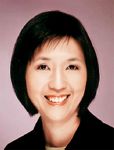
May Kwai Cheong, VP, Central Asia BD
As this region continues to grow, "within Southeast Asia, the role of Singapore will be key since it is a center of gravity, under which a lot of companies oversee the regional markets," concludes Muench.
EMERGING MARKETS: NAVIGATING THE PEARL IN THE OYSTER
Let's not be coy. Singapore's population of 5.3 million does not present global companies many opportunities. However, access to 600+ million in ASEAN clearly does. And although being on site is mandatory for presence in China and India's markets, some companies still use Singapore as a strategic location to juggle the goliaths. Almost half of the world's population can be reached from this little red dot on the map.
Asia is far from homogeneous and its market fragmentation has advantages and drawbacks alike.

Jason Peng, VP Global Operations AB Sciex
The growing middle class is increasingly more educated and consumers have greater health awareness. The top tier of the market, prevalent most in Singapore, Korea and Australia, are increasingly purchasing branded pharmaceuticals. But, the purchasing power does not come easy; consumers are more selective, thereby creating steeper competition.
In the lower, largely untapped markets (60 to 70 percent) of Asia Pacific (APAC), accessibility is the major hurdle. Plans by Indonesia and the Philippines to provide universal healthcare by 2014 and 2016 respectively, further muddles the landscape.
But regardless of which market tiers are targeted, most are opting for a bottom-up approach. Companies realize that bulling through Asia does not work. Instead, strategic planning, flexibility, and reactivity are crucial.

Eitan Konstantino, CEO, TriReme Medical
THE SILICON VALLEY OF THE EAST
As part of the mushrooming BMS, Singapore has been promoting the medical technology industry. Medtech's shorter gestation period and faster growth than the pharma industry has proven increasingly attractive.
"Having catalyzed and built capabilities in the private sector R&D, Bio*One now focuses on later stage companies with products," says EDBI's President and CEO, Swee Yeok Chu, citing medical device companies that are looking to expand into Asian markets as prime examples.
According to the EDB, the medtech industry almost tripled its manufacturing output from SGD 1.5 billion (USD 1.2 billion) in 2000 to about SGD 4.3 billion (USD 3.5 billion) in 2011. The 2015 target is SGD 5 billion (USD 4.1 billion).
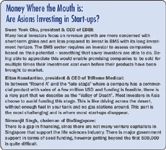
Money Where the Mouth is: Are Asians Investing in Start-ups?
Profitability is spurred by big goals: medtechs aim to propel innovation, contribute to providing more patient-centric solutions and, according to the president of Life Technologies for Asia Pacific and Japan, Mark Smedley, to democratize science.
"We believe tools are what fundamentally drive innovation," says Smedley, who compares their "Ion Proton," genome sequencer to Galileo's telescope. It took a tool, the telescope, to transform Copernicus' theory into science.
Asia: Medtech Mecca
The medtech mantra is converting growth into opportunity. Growth for the medtech industry in Asia is a given, according to Bhuller. China shows 20 to 22 percent annual growth while other Asian countries are growing between 10 to 14 percent.
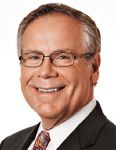
Thomas Dunlap, President & CEO HOYA Surgical Optics
"The challenge is how" fast you can restore your basic operations that can support sustainable growth," says GE's Healthcare president of ASEAN, David Utama.
To build the foundation and keep in line with access, one of the three pillars of its "Healthymagination" campaign, GE has developed a novel approach to alleviate financing of their products.
"Normally the challenge for healthcare practitioners is not cash flow, because they have a good base of operations. The challenge is buying for the first time," explains Utama, who has facilitated working with one of the largest public banks in Indonesia to issue credit cards with low interest options.
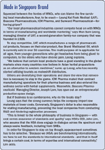
Made in Singapore Brand
For companies like Becton Dickinson (BD), Indonesia is the fastest growing market in the ASEAN region. May Kwai Cheong, BD's Vice President of Central Asia, believes that "as the government and even the private sector increase access, there will always be growth opportunities."
Companies are scrambling to deflate the rising cost pressure that this broadening access surge will create. Cheong says that in order to continue growth, their main challenge will be coming up with "market appropriate products" for the emerging markets, which BD is doing in stages.
"As the region is so diverse, we have a different strategy for each market," says Cheong. "For every country that we consider as high potential, we work with consultants and then internally develop a strategic plan for the respective market, which takes us around 3 to 6 months to design the plan before we execute it."
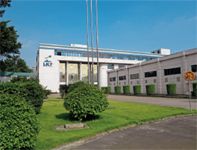
LKF Plant in China
Medtechs have had another recent insight—retrofitting products from the US or Europe does not work. This is true particularly in emerging markets where, according to Kulbir Sandhu, the executive director of Greatbatch's future Active Implantable Medical Device (AIMD) R&D Center, "patient psychology, clinical practise, price point, regulatory compliance and reimbursements" are all different.
With its first foray into Asia Pacific and also Singapore's first AIMD center, Greatbatch, a US-based component supplier for implantables, will be "looking for the clinical opportunity, assessing and understanding what the clinical need is, and based on that we will define and design products (cardiovascular, neuromodulation and orthopaedics) out of this new R&D center," Sandhu says.
Nurturing the Niche Players
Singapore has further positioned itself to focus on producing technologies in select areas such as ophthalmologic, cardiovascular and orthopedics.
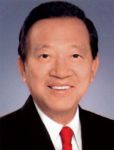
Mun Sum Leong, Managing Director, LKF
Niche players like AB Sciex and HOYA Surgical Optics, a global manufacturer of intraocular lenses (IOLs) that is part of HOYA corporation, are using Singapore as a marketing tool.
Many doctors, especially from Asia, come to visit HOYA Surgical Optics' manufacturing plant. "The visitors are really fascinated to understand what it takes to manufacture an intraocular lens, which look simple, but there is an incredible amount of precision technology involved," says Thomas Dunlap, CEO of HOYA Surgical Optics.
Aside from their manufacturing and commercial footprint, AB Sciex opened the APAC Regional Application & Training Center in the Biopolis in 2012, which will function as a training center and as a lab to promote the capabilities of their mass spectrometry tools. Customers who come to the center not only learn how to use the tools, but can also bring their own samples to test solutions.

Carl Firth, CEO ASLAN
Many of these companies believe that spreading themselves thin can compromise prime positioning.
"Unlike our main competitors, our singular focus frees us of conflicting priorities and distracting demands outside of our core business," says Dunlap, who posits this will continue their double-digit growth.
"We will take a very strong position in the global market place, since we are aiming to be positioned amongst the top two companies in our core intraocular lens business," Dunlap says.
TriReme Medical produced Singapore's first FDA approved implantable device, "Chocolate," a PTA balloon catheter. The device was invented and designed here, in collaboration with their team in Silicon Valley.

Interview with Joseph Lam, managing director of Beacons Pharmaceuticals
Eitan Konstantino, president and CEO of TriReme Medical, who also runs Quattro Vascular, an R&D start- up, calls Singapore a "sweet spot of quality and cost." Although manufacturing in Singapore is more expensive than in neighboring countries, Konstantino says that he is able to reduce costs by 75 percent as compared to California.
Like big pharma, medtechs are also tapping into Singapore's crème de la crème talent.
"Singapore has an amazing talent base that in our niche—mass spectrometry (MS)—is really appreciated, since it is not easy to explain how MS works and here we find talent that learns it at a very fast speed, who are simultaneously very productive and efficient," says Jason Peng, vice president of global operations for AB Sciex.
In spite of the industry's manpower base more than doubling from about 4,000 to 9,000 in the last decade, executives agree that more can be done to foster indigenous talent.
"Singapore could improve in sustainability, by creating a home-grown research business, since we cannot depend on global leaders to do high-level research," says Peng. He insists that translating ideas into products will depend largely on local talent.
JAPAN'S HOME AWAY FROM HOME
Singapore is also taking a piece of the Asia-frenzy. EDB's "Host-to-Home strategy" is not exclusive to the west. Yeoh says that many Asian companies have been coming to Singapore to internationalize.
Due in part to anti-Japanese protests in China, some Japanese companies have traded this once more appealing location for Singapore. According to China's Ministry of Commerce data, Japanese investments have declined considerably in the last quarter of 2012, as compared to the previous year, with a 32.4 percent drop in October.
Dunlap considers establishing HOYA Surgical Optics' global headquarters in Singapore as one of the company's biggest milestones.
"As a Japan centric company from the start, we realized a number of years ago the need to become a global organization and to expand our footprint," says Dunlap. He adds that the company uniformly sees the world "being located in Singapore through a different perspective," a weighty comment from a vision-oriented company.
Another Japanese ophthalmic company, Menicon, developed their most coveted innovation—the world's thinnest one-day disposable contact lens—in Singapore, at its first manufacturing and R&D facility outside of Japan. Menicon invested over USD 100 million in the facility.
Koji Kawaura, managing director of Menicon in Singapore, says that for a corporation that specializes in high-tech products, Singapore is a perfect springboard for developed markets, facilitating better reach to Europe and the US.
"For most companies Asia is a central part of the growth of their business, so it follows that R&D tends to expand in a similar way," says James Garner, vice president and general manager of Takeda Global Research & Development Center, Asia (TGRD Asia). The center serves as Takeda's regional hub for non-oncology clinical development in Asia, excluding Japan.
"Before this center was established, Takeda had limited clinical development activity in Asia. Since the creation of TGRD Asia, 12 percent of global clinical trial subjects are now recruited in this region," he adds.
Chugai, another leading Japanese research-based pharma company announced an investment of SGD 200 million (USD 164 million) in Singapore over the next five years. The investment follows the establishment of Chugai's second research institute in Singapore, an antibody engineering technologies lab, Chugai Pharmabody Research (CPR) this July.
DOES SINGAPORE HAVE THE ANSWERS?
No one believes that the smörgåsbord of eastern opportunities will fix all the problems inherent within the industry. A central theme resonates: Drug development in the industry today does not work, plain and simple.
The collective agreement is that change is needed, "but what really is changing?" asks the industry.
ASLAN Pharmaceuticals' CEO, Carl Firth says that "moving pieces around on an organizational chart is not going to help and creating new acronyms to name a new business unit is not going to help." Risk is the only solution, and sometimes "that means giving up bits that we felt were a vital part of the DNA of the industry," he says.
But who is ready? And does Asia—a playground for those looking to escape the bureaucracy and sometimes, intransigent ways of the west—have any idea of what the DNA consists of?
One of the answers that will certainly mix the double helix is the convergence of industries, primarily medtech and pharma.
"Pharma companies are running out of ideas, their IP are expiring, they need new products/ drugs," says Yoh-Chie Lu, Chairman of Biosensors, the first medical device company listed on the Singapore Exchange (SGX). "In these days we have to think outside of the box and not just say all we need is drugs, but also deliver them in better and more effective ways."
But radical alone won't do it. Neither will complacency.
"Asia won't succeed without the rest of the globe working together," says Mr. Kaw is director Singapore Innovation Center (P&G). "Interdependency will be key to drive more innovation."
This space between malleability and meticulousness, is where Singapore can play the biggest role. With its phenomenal ability to foresee, to plan, and to execute—forging successful partnerships, promoting interdisciplinary research, merging industries, or attracting the brightest scientific acumen—Singapore promises to provide the stability necessary to uphold an exploding Asia, and, in turn, help lead the revitalization of an industry.
